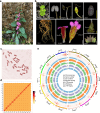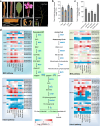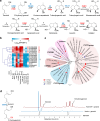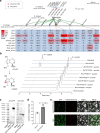Analysis of the Rehmannia chingii geneome identifies RcCYP72H7 as an epoxidase in iridoid glycoside biosynthesis
- PMID: 40593652
- PMCID: PMC12214713
- DOI: 10.1038/s41467-025-60909-9
Analysis of the Rehmannia chingii geneome identifies RcCYP72H7 as an epoxidase in iridoid glycoside biosynthesis
Abstract
Rehmannia chingii (2n = 2x = 28) is an important folk medicinal plant with high therapeutic value, particularly due to its richness in iridoid glycosides. However, research on its evolution and gene functional identification has been hindered by the lack of a high-quality genome. Here, we present the 1.169 Gb telomere-to-telomere (T2T) genome sequence of R. chingii. Phylogenetic analysis confirms that Rehmannia belongs to the Orobanchaceae family. We find that structural genes of the 2-C-methyl-d-erythritol-4-phosphate (MEP) pathway and the iridoid pathway are predominantly expressed in R. chingii leaves. Further analyses reveal a cytochrome P450 gene cluster localized on chromosome 8, and identify RcCYP72H7 within this cluster as an aucubin epoxidase, capable of catalyzing aucubin epoxidation to form catalpol. The genome offers valuable resources for studying iridoid glycoside biosynthesis and the evolutionary history of Rehmannia, and will help to faciliate genetic improvement of R. chingii for pharmaceutical and health-related applications.
© 2025. The Author(s).
Conflict of interest statement
Competing interests: The authors declare no competing interests.
Figures






Similar articles
-
The Hedyotis diffusa chromosome-level genome and multi-omics analysis provide new insights into the iridoids biosynthetic pathway.Front Plant Sci. 2025 Jun 19;16:1607226. doi: 10.3389/fpls.2025.1607226. eCollection 2025. Front Plant Sci. 2025. PMID: 40612608 Free PMC article.
-
Genome-wide identification and integrated analysis of the WNK kinase gene family and expression analysis of PgWNK genes under methyl jasmonate treatment in Panax ginseng.BMC Plant Biol. 2025 Jul 1;25(1):791. doi: 10.1186/s12870-025-06818-x. BMC Plant Biol. 2025. PMID: 40597608 Free PMC article.
-
Diaporthe species on palms - integrative taxonomic approach for species boundaries delimitation in the genus Diaporthe, with the description of D. pygmaeae sp. nov.Stud Mycol. 2024 Dec;109:487-594. doi: 10.3114/sim.2024.109.08. Epub 2024 Oct 23. Stud Mycol. 2024. PMID: 39717652 Free PMC article.
-
Biomarkers as point-of-care tests to guide prescription of antibiotics in people with acute respiratory infections in primary care.Cochrane Database Syst Rev. 2022 Oct 17;10(10):CD010130. doi: 10.1002/14651858.CD010130.pub3. Cochrane Database Syst Rev. 2022. PMID: 36250577 Free PMC article.
-
In silico analysis of the Seven IN Absentia (SINA) genes in bread wheat sheds light on their structure in plants.PLoS One. 2023 Dec 21;18(12):e0295021. doi: 10.1371/journal.pone.0295021. eCollection 2023. PLoS One. 2023. PMID: 38127955 Free PMC article.
References
-
- Liu, Y. F. et al. Bioactive iridoid glycosides from the whole plants of Rehmannia chingii. J. Nat. Prod.79, 428–433 (2016). - PubMed
-
- Yang, M. Q. et al. Rehmannia chrysantha (Rehmanniaceae), a new species from Inner Mongolia, northern China. Phytotaxa265, 177 (2016).
-
- Miao, C. et al. De novo transcriptome analysis identifies RpMYB1 as an activator of anthocyanin biosynthesis in Rehmannia piasezkii. Plant Physiol. Biochem.215, 108964 (2024). - PubMed
-
- Xia, Z. et al. Identification of DNA barcoding in plants of Rehmannia Libosch. ex Fisch. et Mey. and origin of cultivated Rehmannia glutinosa (in Chinese). Chin. Tradit. Herb. Drugs47, 648–654 (2016).
-
- Liu, Y. F. et al. Four new iridoid glycosides from the roots of Rehmannia glutinosa. J. Asian Nat. Prod. Res.10, 1–9 (2023). - PubMed
MeSH terms
Substances
LinkOut - more resources
Full Text Sources

